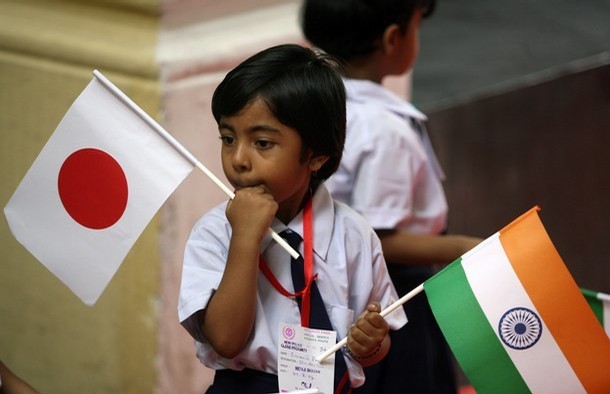 Almost four months have passed since the Manmohan Singh -Shinzo Abe joint statement was issued following their summit meeting held in Tokyo in May, 2013. Some important developments that could transform the India-Japan partnership.
Almost four months have passed since the Manmohan Singh -Shinzo Abe joint statement was issued following their summit meeting held in Tokyo in May, 2013. Some important developments that could transform the India-Japan partnership.
Further have occurred during this period and there is considerable satisfaction in both countries about the follow-up measures taken by both countries.
The most important development is that Emperor Akihito and Empress Michiko will make an official visit to India starting from 30 November. For quite some time, India has shown its eagerness to invite the imperial dignitaries and the May 2013 joint statement makes a specific mention of it. The Emperor's itinerary which includes visits to New Delhi and Chennai is being planned with meticulous care and the government of India has designated a senior congress party leader as a special envoy in charge of coordinating the arrangements for the royal visit.
It is to be noted that Emperor Akihito is no stranger to India having visited the country before he ascended the throne in 1989. His first visit to India in December 1960 soon after his marriage to commoner Michiko and following his assumption of the status of Crown Prince aroused considerable interest in the country. It is indeed amazing to watch some old film clippings showing how a young Akihito and his wife were received at the Delhi airport by Indian Prime Minister Jawaharlal Nehru, President Rajendra Prasad, and Vice-President Radhakrishnan. Far senior in age and experience, the three Indian leaders had themselves paid separate goodwill visits to Japan during 1956-58 which, in a way, helped Japan in its strenuous quest to establish its Asian identity.
Both countries consider the Imperial visit as a very significant landmark capable of giving further impetus to the growing partnership. The fact that the Imperial dignitaries make very rare visits overseas nowadays due to their health conditions, further heightens the importance of their forthcoming sojourn.
Defence cooperation is another area where the two countries have seen great potential for new and mutually beneficial interactions. In their May joint statement, the two leaders had expressed their satisfaction at the expanding defence relations between the two countries in areas such as joint naval exercises and desired to increase their frequencies. For the first time, they also agreed to explore the prospects of Japan selling its indigenously made US- 2 amphibious aircraft to India. They also decided to set up a joint working group to examine the modalities of cooperation on the issue. Given Japan's extreme sensitivity to arms sales to foreign countries, its decision to sell aircraft to India came as a big surprise to everyone. If the deal went through successfully, it would be the first instance of Japan's export of defence hardware to a major Asian country.
A Japanese defence delegation visited India in the second week of July this year and held discussions with the Indian security establishment to take defence cooperation to the next level of involving transfer of technology and equipment. Though Japan had adopted a decision in 1967 to ban export of military technologies to foreign countries, it modified its position in 2011 and opted for gradually relaxing its export policy. Many in India seem to prefer joint defence production with Japan instead of importing Japanese finished products. In this connection, one should also note how Japan has been steadily removing many Indian companies from its export control list.
Another important development is that both India and Japan resumed their negotiations for reaching an agreement on civilian nuclear cooperation. Though they had conducted three rounds of talks until 2010, the Fukushima tragedy became a formidable barrier to any further bilateral talks. But the prospects of an accord brightened after Abe's return to power and the fourth round of negotiations was resumed on 3 September in an atmosphere marked by cautious optimism. Unfortunately, the two countries could not achieve any breakthrough and stood by their well-stated positions on the issue.
Right now, the atmospherics are not all that favourable due to reports of massive leaks of radioactive water in Fukushima Daiich-1, vigorous anti -nuclear agitations carried on by several private groups and the current termination of the operations of all fifty nuclear plants across the country. But with Abe seriously committed to a policy of using civilian nuclear option and the influential business interests supporting him, one has to exercise patience and bide time before an agreement is reached. On 17 September, Prime Minister Abe assured Ashwani Kumar, the visiting special envoy of Manmohan Singh, that he would vigorously pursue negotiations for an agreement on civilian nuclear cooperation. Many in both India and Japan hope that there could be a breakthrough by the time Prime Minister Abe visits India before the end of the year for the next annual summit..
Finally, considering the current steep depreciation of Indian rupee, both countries decided to expand their prevailing currency swap arrangements from 15 to 50 billion US dollars. A joint press statement issued on 6 September, 2013 pointed out that it was necessary to pursue the reform of the financial and investment sectors that will ultimately strengthen the bilateral financial cooperation between the two countries.
By Special Arrangement with : Observer Research Foundation (www.orfonline.org)